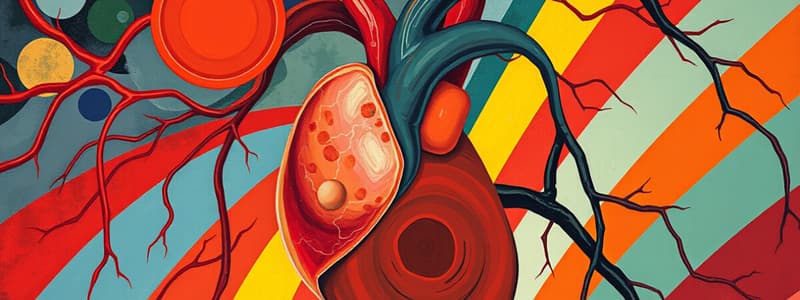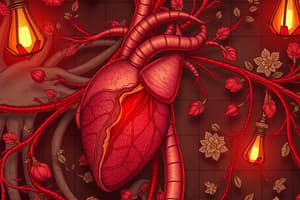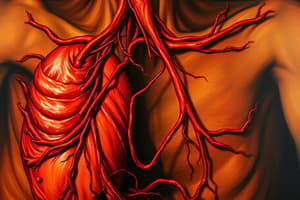Podcast
Questions and Answers
What is one of the primary roles of endothelial cells in maintaining hemostasis?
What is one of the primary roles of endothelial cells in maintaining hemostasis?
- To promote platelet aggregation
- To inhibit coagulation processes (correct)
- To induce vascular injury
- To enhance thrombus formation
What happens to the balance of endothelial cell activities after vascular injury?
What happens to the balance of endothelial cell activities after vascular injury?
- They enhance only fibrinolytic effects
- They solely exhibit antiplatelet properties
- They can exhibit numerous procoagulant activities (correct)
- They stop all coagulation processes
Which of the following substances exhibit antiplatelet effects on endothelial cells?
Which of the following substances exhibit antiplatelet effects on endothelial cells?
- Vitamin K
- Collagen
- Thrombin
- Prostacyclin (PGI2) (correct)
What is one main characteristic of a functional endothelium in relation to blood flow?
What is one main characteristic of a functional endothelium in relation to blood flow?
Which component is NOT involved in the process of hemostasis and thrombosis?
Which component is NOT involved in the process of hemostasis and thrombosis?
What role does nitric oxide play in the context of endothelial cell function?
What role does nitric oxide play in the context of endothelial cell function?
Which of the following processes is specifically prevented by an intact endothelium under normal circumstances?
Which of the following processes is specifically prevented by an intact endothelium under normal circumstances?
What role does thrombin play in the coagulation process?
What role does thrombin play in the coagulation process?
Which of the following properties is not typically exhibited by healthy endothelial cells?
Which of the following properties is not typically exhibited by healthy endothelial cells?
Which proteins act as natural anticoagulants in the coagulation process?
Which proteins act as natural anticoagulants in the coagulation process?
What is the primary function of plasmin in the clotting process?
What is the primary function of plasmin in the clotting process?
How is plasminogen converted to plasmin?
How is plasminogen converted to plasmin?
What happens to free plasmin to prevent it from causing excessive clot breakdown?
What happens to free plasmin to prevent it from causing excessive clot breakdown?
Why is it important to restrict activation of the coagulation cascade to local sites of vascular injury?
Why is it important to restrict activation of the coagulation cascade to local sites of vascular injury?
Which coagulation assay measures the effectiveness of the extrinsic pathway?
Which coagulation assay measures the effectiveness of the extrinsic pathway?
Which of the following factors does thrombin activate during the coagulation cascade?
Which of the following factors does thrombin activate during the coagulation cascade?
What direction do arterial thrombi typically grow from their point of attachment?
What direction do arterial thrombi typically grow from their point of attachment?
Which of the following correctly describes venous thrombi?
Which of the following correctly describes venous thrombi?
What are the lines of Zahn associated with?
What are the lines of Zahn associated with?
What is a common consequence of deep venous thrombosis?
What is a common consequence of deep venous thrombosis?
Which type of thrombus is most likely to be occlusive?
Which type of thrombus is most likely to be occlusive?
Which condition is primarily associated with the formation of cardiac mural thrombi?
Which condition is primarily associated with the formation of cardiac mural thrombi?
What is the primary cause of venous thrombosis?
What is the primary cause of venous thrombosis?
What type of embolus is most commonly found in embolism cases?
What type of embolus is most commonly found in embolism cases?
Which of the following is a potential consequence of venous thrombosis?
Which of the following is a potential consequence of venous thrombosis?
What is the primary initiator of thromboses related to arterial health?
What is the primary initiator of thromboses related to arterial health?
Which risk factor is NOT commonly associated with deep venous thrombosis?
Which risk factor is NOT commonly associated with deep venous thrombosis?
What is the primary component of an arterial thrombus?
What is the primary component of an arterial thrombus?
Which type of thrombus is formed most significantly in slow circulation?
Which type of thrombus is formed most significantly in slow circulation?
How has the rate of fatal pulmonary emboli changed over the last quarter century?
How has the rate of fatal pulmonary emboli changed over the last quarter century?
What condition can cause atrial mural thrombi related to mitral valve stenosis?
What condition can cause atrial mural thrombi related to mitral valve stenosis?
What term describes a detached mass carried by the blood to a distant site?
What term describes a detached mass carried by the blood to a distant site?
What is the primary source of venous emboli in more than 95% of cases?
What is the primary source of venous emboli in more than 95% of cases?
What percentage of pulmonary emboli are considered clinically silent?
What percentage of pulmonary emboli are considered clinically silent?
What condition may occur when 60% or more of the pulmonary circulation is obstructed by emboli?
What condition may occur when 60% or more of the pulmonary circulation is obstructed by emboli?
What percentage of systemic thromboembolism arises from intracardiac mural thrombi?
What percentage of systemic thromboembolism arises from intracardiac mural thrombi?
Which of the following is NOT a predisposing factor for deep vein thrombosis (DVT)?
Which of the following is NOT a predisposing factor for deep vein thrombosis (DVT)?
What is the fatality rate associated with fat embolism syndrome?
What is the fatality rate associated with fat embolism syndrome?
What treatment is commonly administered for deep vein thrombosis?
What treatment is commonly administered for deep vein thrombosis?
Where do most systemic thromboemboli typically end up?
Where do most systemic thromboemboli typically end up?
Study Notes
Hemodynamic Disorders and Circulation
- Health of cells and tissues is reliant on intact circulation for oxygen delivery and waste removal.
- Normal fluid homeostasis is essential to keep blood in liquid form until clot formation is necessary.
Hemostasis and Thrombosis
- Hemostasis is a tightly regulated process that maintains blood in a fluid state and promotes localized clot formation at injury sites.
- Key components involved are the vascular wall, platelets, and the coagulation cascade.
Endothelial Cells and Hemostasis
- Endothelial cells balance antithrombotic and prothrombotic activities, impacting clot formation or dissolution.
- They have antiplatelet, anticoagulant, and fibrinolytic properties under normal conditions.
Antithrombotic Properties
- Antiplatelet effects include blocking platelet adhesion and aggregation.
- Anticoagulant effects involve heparin-like molecules and thrombomodulin, preventing excessive clotting.
- Fibrinolytic activity is conducted by endothelial cells to dissolve blood clots when necessary.
Coagulation Cascade
- The cascade is a series of enzymatic activations that lead to thrombin formation, which converts fibrinogen to fibrin.
- The process must be localized to prevent widespread clotting, moderated by natural anticoagulants: antithrombins, proteins C and S, and tissue factor pathway inhibitor (TFPI).
- Fibrinolysis is managed by plasmin, generated from plasminogen, which dissolves the fibrin in clots.
Thrombus Characteristics
- Thrombi are formed by the attachment of a clot to the vascular surface, with arterial thrombi growing retrograde and venous thrombi extending with blood flow.
- Thrombi show lamination, known as lines of Zahn, and can occur as mural thrombi within heart chambers or aortic lumen.
Clinical Correlations: Venous vs. Arterial Thrombosis
- Thrombi obstruct blood flow and can lead to emboli; venous thrombi risk embolization to the lungs, potentially causing death.
- Arterial thrombi primarily obstruct critical vessels, leading to tissue infarction.
Venous Thrombosis (Phlebothrombosis)
- Most commonly occurs in superficial or deep leg veins, particularly in the presence of varices.
- Deep venous thrombosis (DVT) is more serious as it may embolize, occurring often due to stasis or hypercoagulable states.
Cardiac and Arterial Thrombosis
- Atherosclerosis can initiate thrombosis through endothelial damage and abnormal flow.
- Cardiac mural thrombi may arise post-myocardial infarction or due to rheumatic heart disease.
Embolism
- An embolus can be any dislodged mass (thrombus, fat droplet, air bubble, etc.) that travels through the bloodstream.
- The most common type is thromboembolism, where a portion of a thrombus detaches and causes ischemia in distant tissues.
Pulmonary Thromboembolism
- Incidence estimated at 20 to 25 per 100,000 hospitalized patients, with approximately 200,000 annual deaths in the U.S.
- Most cases originate from DVTs in deep leg veins; many pulmonary emboli are clinically silent but can lead to sudden death if significant obstruction occurs.
Systemic Thromboembolism
- Refers to emboli within arterial circulation, largely arising from cardiac sources like mural thrombi.
- Common sites for obstruction include lower extremities and the brain.
Deep Vein Thrombosis (DVT) Predisposing Factors
- Risk factors include immobility, pregnancy, post-operative conditions, severe burns, heart failure, and cancer.
- High-risk patients should receive preventive measures like heparin and leg compression during surgery.
Fat Embolism
- Associated with fractures of long bones or soft tissue trauma, resulting in microscopic fat globules in circulation.
- Symptoms include pulmonary insufficiency, neurological issues, anemia, and thrombocytopenia; fatality rate is about 10%.
Studying That Suits You
Use AI to generate personalized quizzes and flashcards to suit your learning preferences.
Related Documents
Description
This quiz covers essential concepts related to hemodynamic disorders, thrombosis, and shock. Explore the intricate processes that regulate blood circulation, hemostasis, and the significance of proper fluid homeostasis in maintaining health. Understand how these factors contribute to tissue oxygenation and waste removal.




